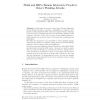Free Online Productivity Tools
i2Speak
i2Symbol
i2OCR
iTex2Img
iWeb2Print
iWeb2Shot
i2Type
iPdf2Split
iPdf2Merge
i2Bopomofo
i2Arabic
i2Style
i2Image
i2PDF
iLatex2Rtf
Sci2ools
HIP
2005
Springer
2005
Springer
Phish and HIPs: Human Interactive Proofs to Detect Phishing Attacks
In this paper, we propose a new class of Human Interactive Proofs (HIPs) that allow a human to distinguish one computer from another. Unlike traditional HIPs, where the computer issues a challenge to the user over a network, in this case, the user issues a challenge to the computer. This type of HIP can be used to detect phishing attacks, in which websites are spoofed in order to trick users into revealing private information. We define five properties of an ideal HIP to detect phishing attacks. Using these properties, we evaluate existing and proposed anti-phishing schemes to discover their benefits and weaknesses. We review a new anti-phishing proposal, Dynamic Security Skins (DSS), and show that it meets the HIP criteria. Our goal is to allow a remote server to prove its identity in a way that is easy for a human user to verify and hard for an attacker to spoof. In our scheme, the web server presents its proof in the form of an image that is unique for each user and each transact...
| Added | 27 Jun 2010 |
| Updated | 27 Jun 2010 |
| Type | Conference |
| Year | 2005 |
| Where | HIP |
| Authors | Rachna Dhamija, J. D. Tygar |
Comments (0)

